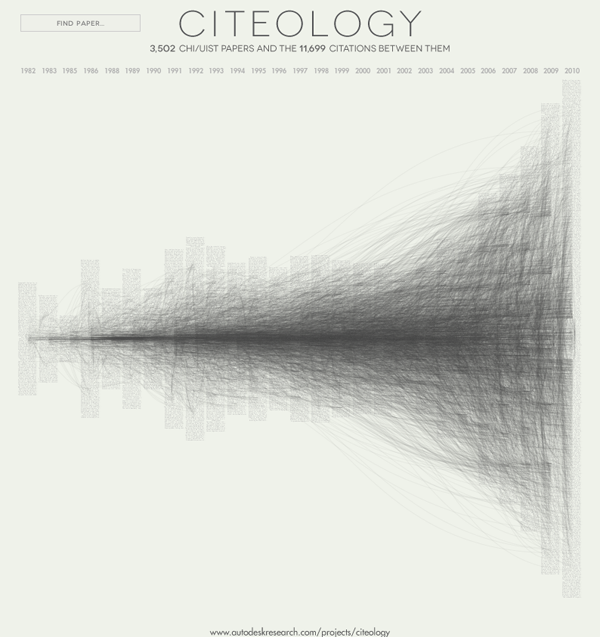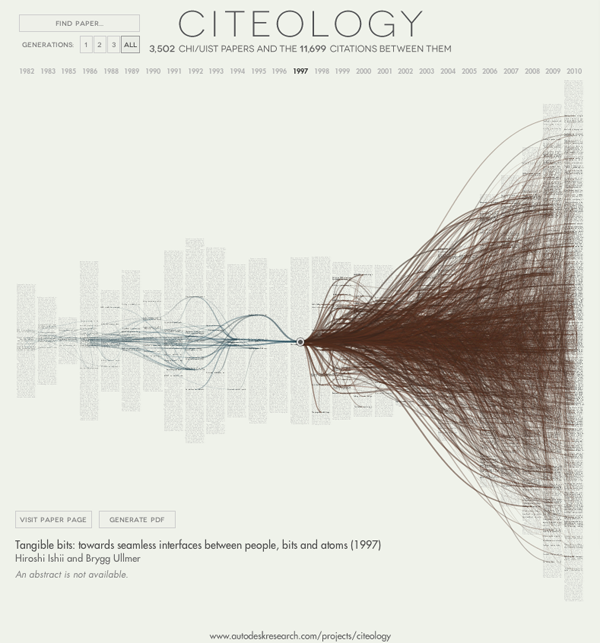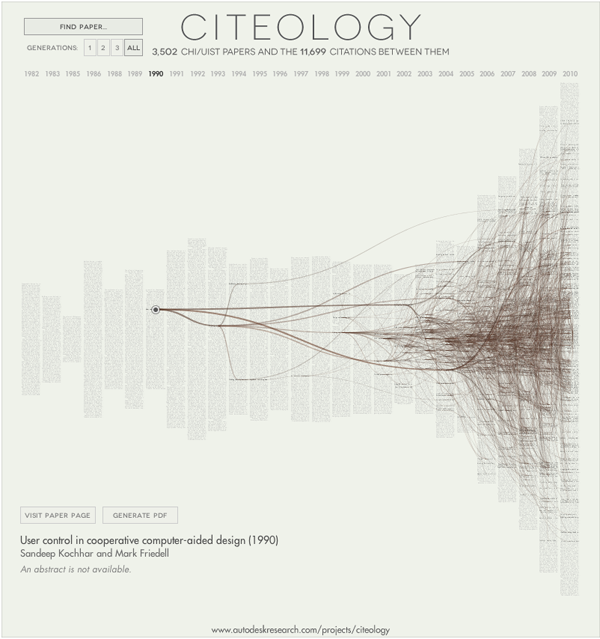
Step 1
The image above was constructed using the citations from the CHI/UIST papers. CHI stands for Computer-Human Interaction; UIST stands for User-Interface Software and Technology; both are considered to be important and maybe even ‘cool’ by product designers, software designers, and those on the peripherals of the space between product design and software design. UIST had their 24th annual conference in 2011 and CHI started in 1982. By way of full disclosure: Autodesk is a major sponsor of UIST. They paid the people who put this graphic together, too.
The graphic above took the conference proceedings from these two conferences as datasets, compiling all of the articles that were included and their references. Each of the small grey-ish bars is an article.

Step 2
Hovering a mouse over a grey-ish bar will pop up the actual title of the article. Clicking on the bar will bring up a graphic that displays both the articles which the original article cited (in blue) and the articles published after the original article that referred to the original article (in brown).
What works
How is this thing useful? Well, compare the article above about Tangible Bits with the article below about Cooperation in Computer-Aided Design. It is easy to see that The Tangible Bits article is more clearly within the mainstream of this new sub-discipline because it both refers to articles that were published in these two proceedings and is then widely referred to by future publications in the proceedings. The Cooperative Design piece was less firmly situated in the discipline, which is instantly obvious because they did not include citations from within the proceedings in their article (and they have fewer citations by others for quite a few years before this older article gets popular again). Things like disciplines and sub-disciplines are difficult to understand, difficult to define, have fuzzy borders, and suffer from all sorts of other kinds of infringements on their existence. This visualization technique at least allows us to see some of that border-making work happen by following citation patterns.

To be fair, the Cooperative Computer-Aided Design paper was written when these conferences were still being established and thus the number of articles available in the proceedings were smaller back in 1990. What’s more, it was probably still a little unclear just exactly what kind of sub-discipline CHI and UIST would come to define. Building up a new research field does not happen overnight and some of the things that seem relevant at first, turn out to fit in better elsewhere.
What needs work
It is a little unclear just how important it is to understand the boundaries of a discipline. For an academic trying to shape a particular kind of career, one in which they believe getting published in CHI or UIST is important, I guess it would be nice to have something like this so they can figure out what the core of popular articles has been so they can get themselves in the stream they’d like to be in. On the other hand, I’m not sure it is always good for academics to create loops in which everyone is citing the things everyone else in their circle has read. Seems problematically narrow to me. Maybe a graphic like this could demonstrate such a narrowing (one would expect the number of cites to grow for a while and then plateau in a false narrowing situation rather than to continue to expand exponentially in a more open-minded, exploratory research field). However, my beef with this kind of thing is that it seems that as a *tool* it will be used to help induce closure in the circle of citations. At the moment, it doesn’t seem like this is happening, but then, we might not expect the closure to be evident until after authors have had a chance to use the tool for a while to help them figure out what to read and cite when they submit to these journals. It does seem like some kind of narrowing of the field happened in about 1992-ish where a plateau in the total number of articles being cited is evident. I would imagine that was a kind of natural impact of having finally settled upon a definition of what the field would be, a necessary winnowing process so that the sub-discipline could find its boundaries and come into existence as a clearly defined entity (a column of water in a glass) rather than spreading out to encompass a little bit of everything (the same water poured out over a table).
Giving credit where it’s due
Thanks to Letta Wren Page, an editor at The Society Pages, for sending the Citeology visualization along.
References
Autodesk. (2010) Citeology Part of the Visualization Project within the Learning Project group.

Comments 2
Justin Matejka — January 4, 2012
I'm glad that you find Citeology interesting, and I think this is an excellent analysis of the tool. Thanks for taking the time to write about it.
Letta Page — January 4, 2012
As I just commented over at The Editor's Desk on a post of Chris Uggen's about Google Scholar and high-impact publication, my favorite part of your analysis here really gets at what (at least I think) TheSocietyPages is about:
"It is a little unclear just how important it is to understand the boundaries of a discipline. For an academic trying to shape a particular kind of career... I guess it would be nice to have something like this so they can figure out what the core of popular articles has been so they can get themselves in the stream they’d like to be in. On the other hand, I’m not sure it is always good for academics to create loops in which everyone is citing the things everyone else in their circle has read. Seems problematically narrow to me."
Hear, hear!